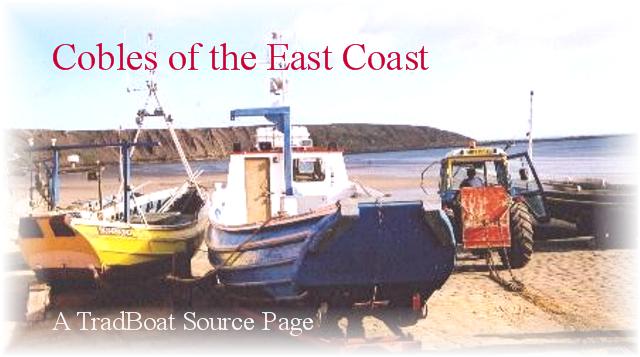
This
page brings together a number of sources of information concerned with the
distinctive Cobles, many of which were designed to be launched off the gently
sloping but often stormy beaches of the East and North East Coasts. We
hope that the page will be of interest to those looking for more information
about the boats themselves, and also to model makers. We welcome more
information at TradBoat which we will be happy to add to this page - please
email us at tradboat2017@gmail.com
| This page
normally has frames to left and rightt. If you are seeing it without, please
click here |
An introduction to the Yorkshire Coble.
Filey Cobles.
The fleet in the
fifties and sixties
At
that time the Coble Landing was home to perhaps twenty cobles, each with the
distinctive deep forefoot, running off to sledge like lines aft and a transom
stern on which was mounted a deep slim rudder. With the deep forefoot, this
helped to hold the boat to sea. These two hazy black and white photographs were taken in the early 50s, of the
Coble Landing at Filey on the Yorkshire coast.
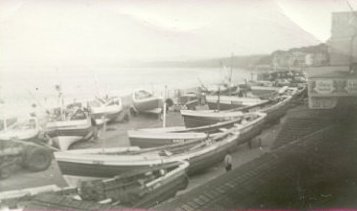 |
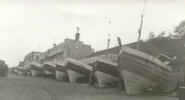
|
| On the Coble Landing, Filey |
From the bow |
Originally under sail only, (usually a standing lug) many of the boats
still had sailing gear aboard, but by this period (1950s) many were
motorised; the shaft and propeller running in a tunnel protected by twin bilge
keels (or drafts). The fishery was a busy one, long lining and crabbing, supplemented in
summer by trips around the bay and fishing for visitors.
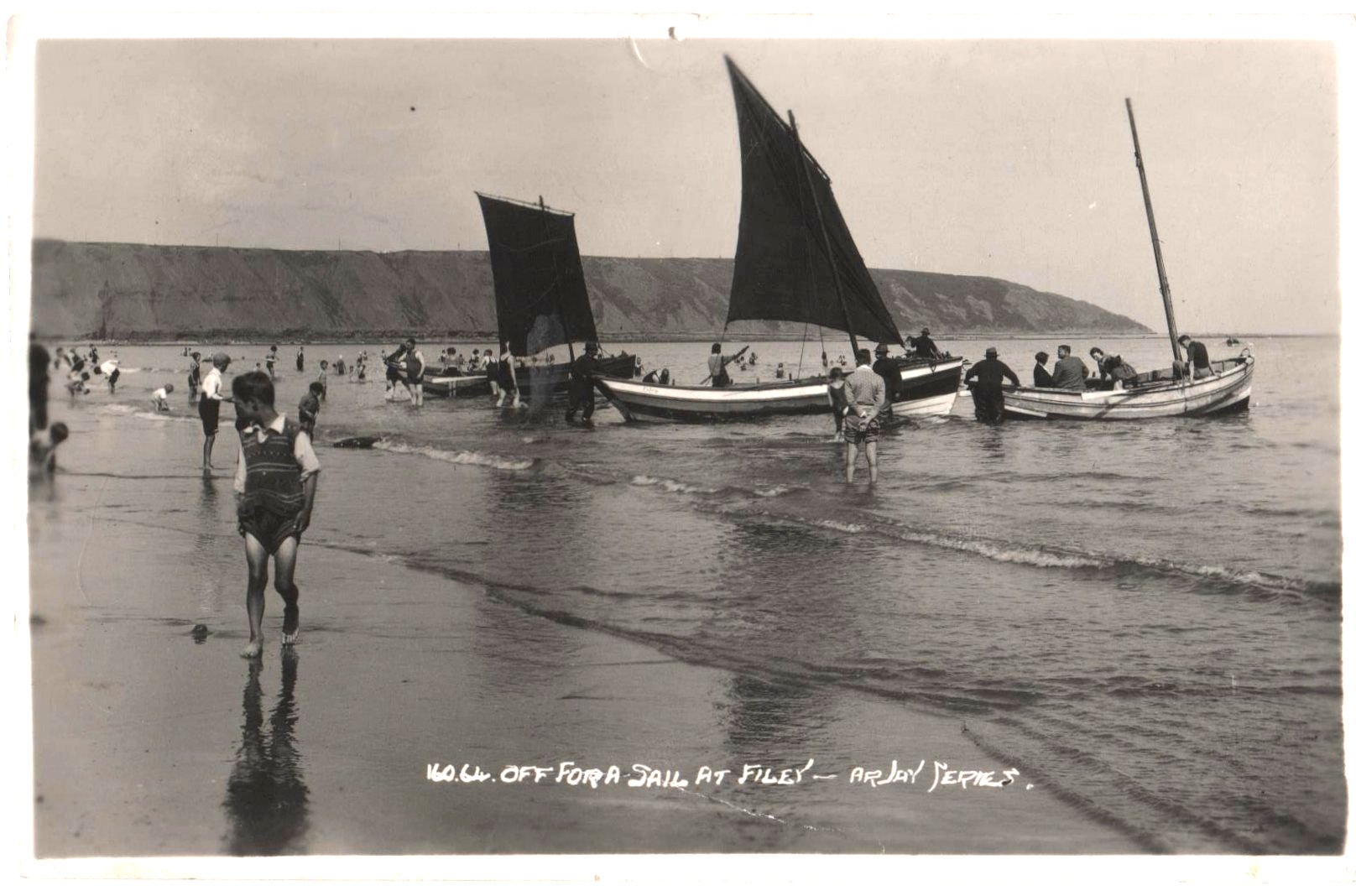 |
Holiday makers
going afloat off Filey beach.
Note the holiday wear of the time!
The standing lug sails are typical. 1954 (R Jay
Series) |
Launch and
Recovery
The boats are all kept ashore on
lorry-wheeled launching trolleys or cradles. Originally horses had been used
for launch and recovery, both for the cobles and the Filey Life Boat, but by
the fifties were tractor hauled, leaving distinctive skid trails on the smooth
sandy beach. The same system operates today.
Bringing a coble ashore on Filey beach.
(2003). The bows are swung to the incoming surf and the boat is hauled
out backwards. The
tide was down and the surf was small on this day, recovery a
straightforward job of dropping the boat on to its cradle, where is sits
securely on its drafts (runners). In contrast to the wide stretches of beach seen when the tide is down,
here below is a beautifully evocative photograph by Tony Green showing a coble is
coming ashore right at the foot of the landing on a cold November day.
Unloading
Click on any small photograph for a larger version
The Filey
Cobles 2003
The following series
of photographs is of Filey boats, stored ashore and designed to be launched
from the flat sands into sometimes considerable head seas. In the main, the sailing
gar had been removed which has made way for a forward wheelhouse. They
retain the typical deep forefoot, pronounced sheer and considerable
tumblehome of the type. Twin bilge runners (drafts) run right
aft. These photographs also show the flat, heavily raked, transom and the
attachment points at the end of the drafts to which towing slings are hooked . Click on any photograph below for a larger version.
.
Click on
any small photograph for a larger version
These Filey cobles
represent the basic coble shape seen all the way up the East and North East
coast.. However, the boats tended to be built by local builders to suit
the conditions in which they were worked. Design varies from place to
place and from builder to builder. Builders would also vary their basic
design a little to suit the fisherman who might specialise one part
of the fishing trade, or have strong views about his boat! The modern cobles
often have a small wheelhouse forward, perhaps a half deck to shelter the
engine, and gantries to support line haulers; both possible because
there is now no sailing gear. It's interesting to compare these modern
Filey boats with the black white photographs above taken over fifty years ago.
The Filey coble Margaret has been restored
fully further details are here
Robin Hood's Bay 2007
When we visited Robin Hood's bay in the summer
of 2007 we found that the cobles had gone and none were left on the
landing at the foot of the narrow winding road which leads down to the
sea. Venture here was in the car park at the top of the hill
together with a second double ender.
Whitby Cobles in 2007
There are a number of cobles in harbour at Whitby for
the most moored to the South wall of the inner dock. Many are larger
cobles with the usual forward wheelhouse. There is a busy fishery here
and long stacks of crab pots can be seen on the wall at both sides of the
harbour.
Click on
any small photograph above for a larger version
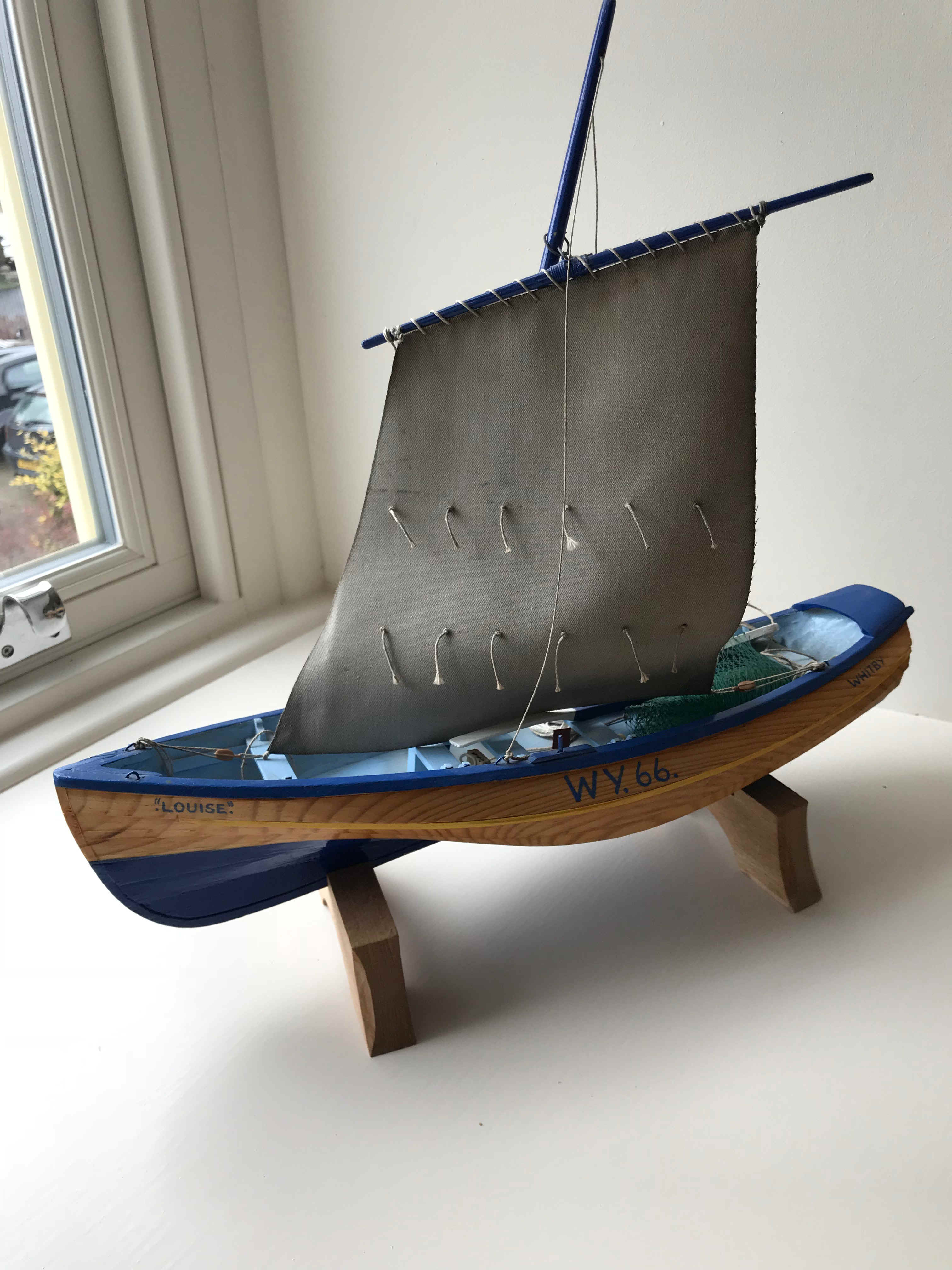
|
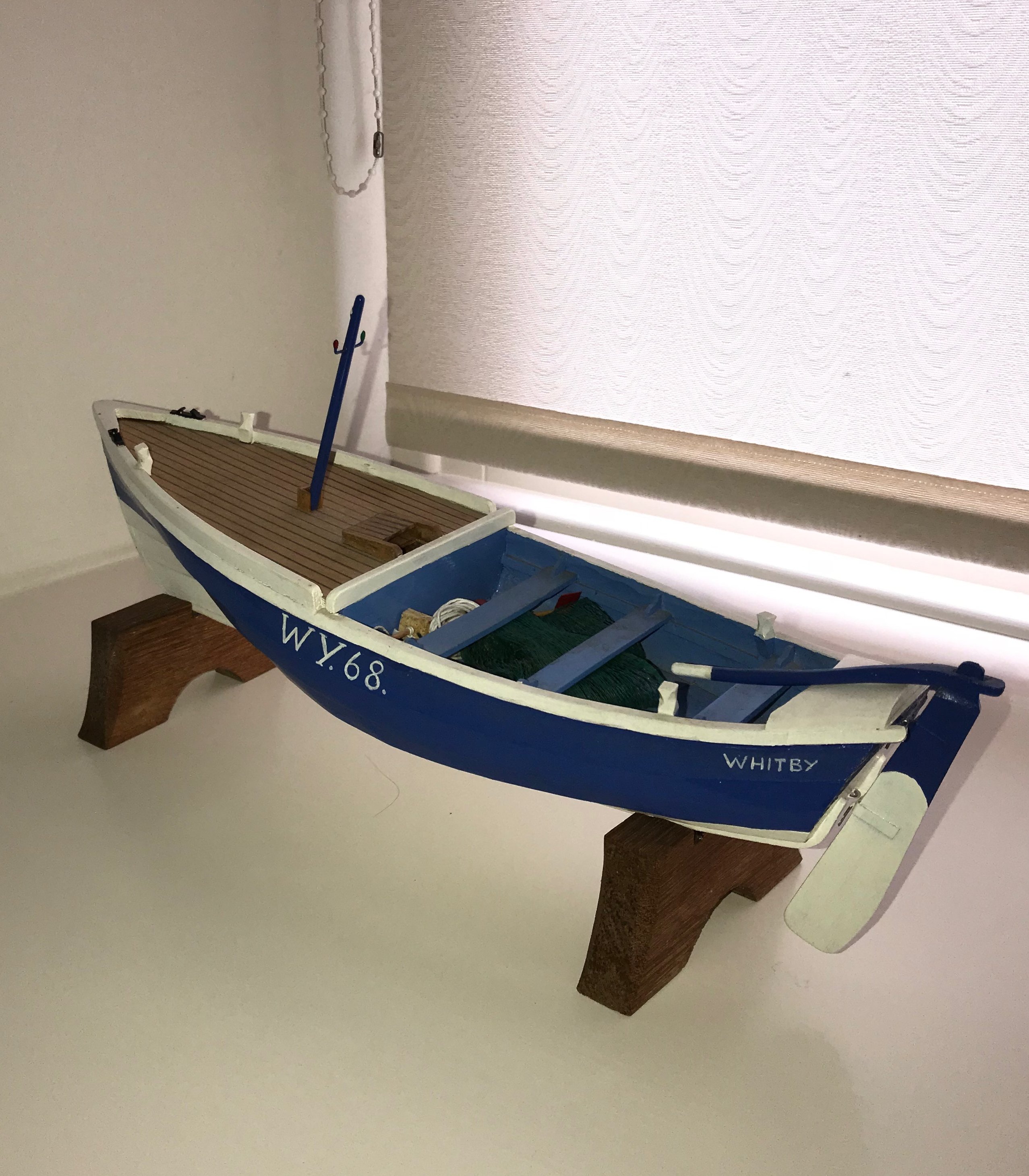
|
These two beautifully crafted models were
presented to Captain Richard Braithwaite on his retirement as MD of a
coble ownership based for many years in Whitby. They are named
after his two daughters Louise (left), and Helen (right). Photos Louise
Braithwaite.
|
Staithes Cobles in 2007
Although nothing like as numerous as they were in the
past there are number of cobles at Staithes mostly moored in the river with
several against the outer harbour wall. Few of these boats are
registered in the fishery and many that remain are in private hands. Unlike
the Filey cobles these boats are kept afloat although at low tide the harbour
dries and the river is reduced to a stream.
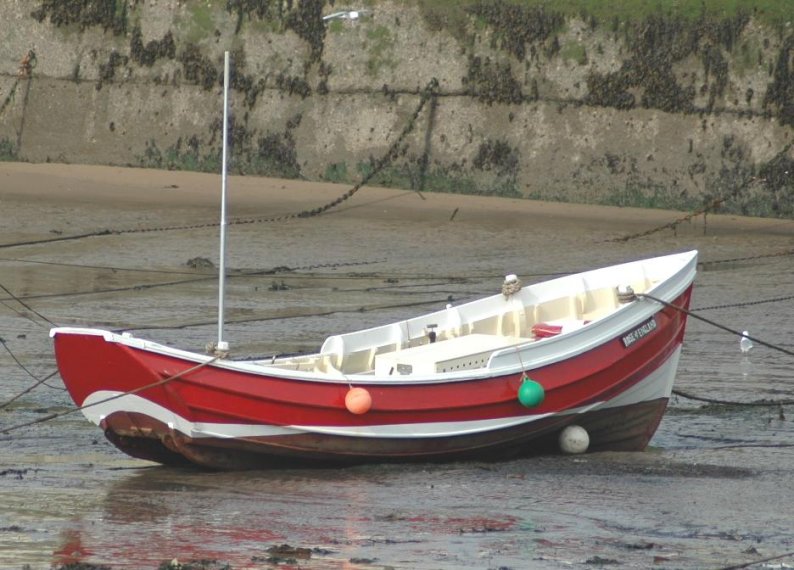 |
|
Against the harbour wall.
Staithes. |
Boats moored in the River at Staithes
 |
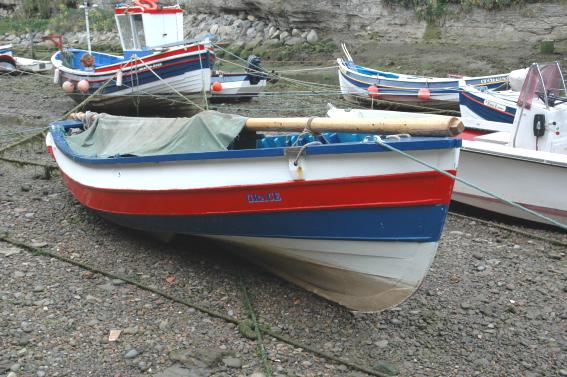 |
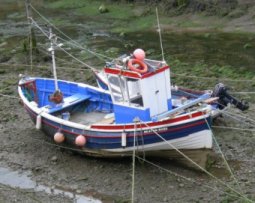 |
 |
| Moored below the
bridge |
The coble Grace
with
sailing gear aboard |
Seaton -Rose moored in the
river |
True Love a double
ended coble |
Click on
either photograph above for a larger version
Postcards
North Landing, Flamborough
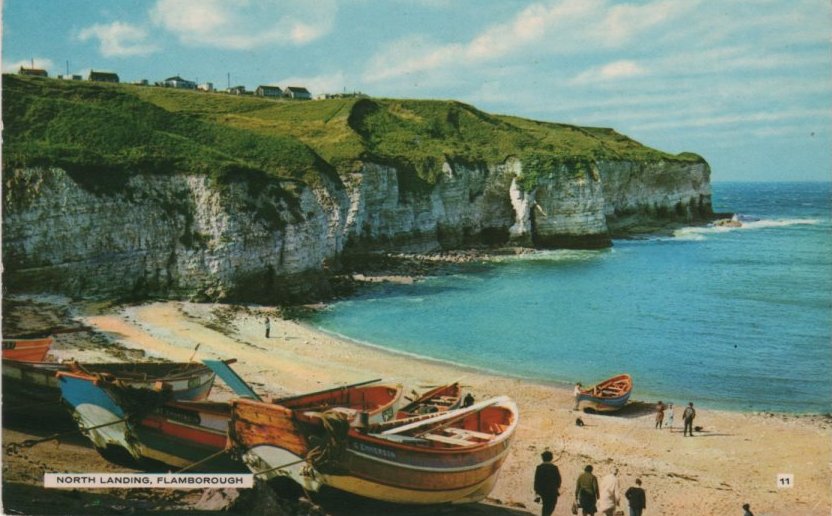 |
|
A Bamforth postcard, published in
Holmfirth, Yorkshire and printed in Holland |
U-Tube:
Beach Recovery at Flamborough here: https://www.youtube.com/watch?v=xqxxz99EQqM
Scarborough
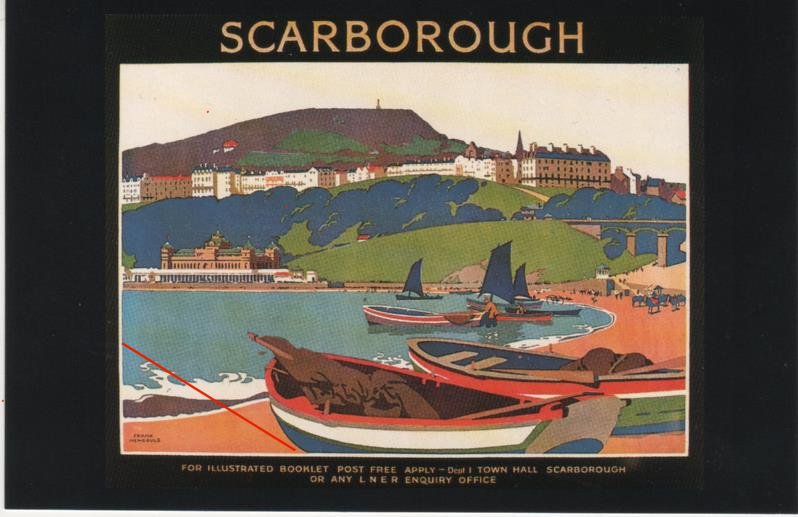 |
|
The original of this postcard is based on a poster designed by
Frank Newbould for the LNER, c. 1924.
This reproduction is by IRIS Publishing
Ltd in their Nostalgia series. More details at www.retrograph.com'
|
Other  Sources
Sources
A big Bridlington coble
- Three Brothers built in 1912 and since
restored
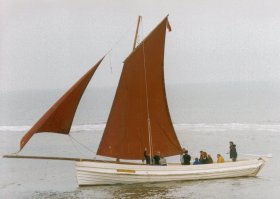 In
contrast to the Filey boats this is Three Brothers; restored and to be
seen under sail. She
has less sheer than usual and so is much flatter to allow beam trawling as
well as passenger carrying. Like the Filey boats, these Bridlington
cobles had no keel, and were held up to the sea by very deep rudders, which
could be unshipped in harbour, or on the beach, and used as gangplanks. Unlike
the Filey boats they returned to harbour. Sixty years ago there were a great
many sailing cobles in Bridlington, and the fishermen were extraordinarily
skilful in handling them, with the final position against the pier being made
by oar and a 30ft. boathook.
In
contrast to the Filey boats this is Three Brothers; restored and to be
seen under sail. She
has less sheer than usual and so is much flatter to allow beam trawling as
well as passenger carrying. Like the Filey boats, these Bridlington
cobles had no keel, and were held up to the sea by very deep rudders, which
could be unshipped in harbour, or on the beach, and used as gangplanks. Unlike
the Filey boats they returned to harbour. Sixty years ago there were a great
many sailing cobles in Bridlington, and the fishermen were extraordinarily
skilful in handling them, with the final position against the pier being made
by oar and a 30ft. boathook.
 The
Three Brothers was built in Bridlington by father and son Baker
and Percy Siddall in 1912. It seems to be the last of the sailing cobles. Two
other Bridlington cobles are now in Sunderland: the Kate & Violet and
Kathleen. This photograph, taken during her restoration, provides
some details of her massive construction. Click on the picture for a
larger view.
The
Three Brothers was built in Bridlington by father and son Baker
and Percy Siddall in 1912. It seems to be the last of the sailing cobles. Two
other Bridlington cobles are now in Sunderland: the Kate & Violet and
Kathleen. This photograph, taken during her restoration, provides
some details of her massive construction. Click on the picture for a
larger view.
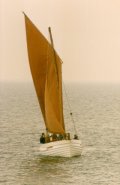 Bridlington
Sailing Coble Preservation Society web site carries additional photographs
of Three Brothers together with older coble photos and a history of the
builder. The Society, has taken over the running of the small harbour
museum in Bridlington known as Harbour Heritage. The
Three Brothers restored by Bridlington Harbour Commissioners and owned
by them, is now leased to the Society and used as a working exhibit for the
Harbour Heritage museum. Membership is welcome.
Bridlington
Sailing Coble Preservation Society web site carries additional photographs
of Three Brothers together with older coble photos and a history of the
builder. The Society, has taken over the running of the small harbour
museum in Bridlington known as Harbour Heritage. The
Three Brothers restored by Bridlington Harbour Commissioners and owned
by them, is now leased to the Society and used as a working exhibit for the
Harbour Heritage museum. Membership is welcome.
This coble is cared for by the Bridlington Sailing Coble Preservation
Society - for more information click https://bridlington.net/bridlington-history/bridlington_history_listing/three-brothers/
U-Tube: There is an excellent
film of Bridlington Cobles to be found here: https://www.youtube.com/watch?v=RKLZ5jcM34A
The Coble & Keelboat Society
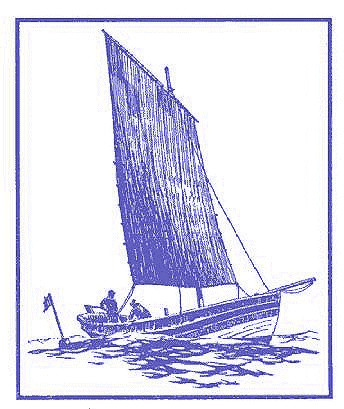 The
Society brings together all those interested in the working boats of the North
East of England and has over 100 members in Britain, Europe and North
America. Membership includes professional fishermen and amateur sailors,
historians and ship modellers. All find the local boats - the
traditional fishing cobles and the larger decked inshore trawlers (or
Keelboats) for example.. CKS holds several meetings
on the coast each year, publishes a journal three times a year and is always
ready to help with queries about these craft.
The
Society brings together all those interested in the working boats of the North
East of England and has over 100 members in Britain, Europe and North
America. Membership includes professional fishermen and amateur sailors,
historians and ship modellers. All find the local boats - the
traditional fishing cobles and the larger decked inshore trawlers (or
Keelboats) for example.. CKS holds several meetings
on the coast each year, publishes a journal three times a year and is always
ready to help with queries about these craft.
Web: https://coble-keelboatsociety.org/
Models and preserved Cobles at Hartlepool
Historic Quay
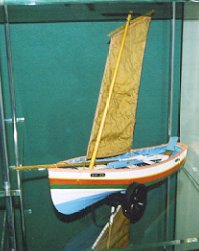 The
Hartlepool Historic Quay is a serious source for those interested in these
fishing boats. The museum has a selection of models illustrating the
boats by type, well set out explanations of each type, plus three full size
cobles on shore. Two
of these are typical of the robust transom sterned types and one of these is
displayed complete with rig in the museum building. Of the other
two displayed on the quayside one is a double ended type.
The
Hartlepool Historic Quay is a serious source for those interested in these
fishing boats. The museum has a selection of models illustrating the
boats by type, well set out explanations of each type, plus three full size
cobles on shore. Two
of these are typical of the robust transom sterned types and one of these is
displayed complete with rig in the museum building. Of the other
two displayed on the quayside one is a double ended type.
(The Quay is also home to Trincomalee,
(ex Foudroyant) in Jackson Dock, and the locally built paddle steamer Wingfield
Castle. There are displays in a series of restored shops and store
houses. We found it excellent, and the staff most helpful. Ed)
Web: http://www.thisishartlepool.co.uk/attractions/historicquay.asp
Model Coble Plan
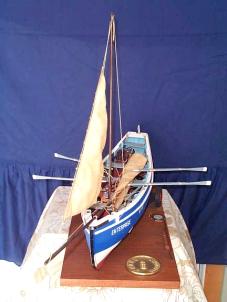 A
plan is available for a Northumbrian Coble at a scale 1" = 1ft, resulting
in a model about 27" loa. It is published (2004) by Model Boats
magazine. Go to www.modelboats.co.uk
and then to My Hobby Store, then click on Scale Sailing Craft, you are looking
for Enterprise plan number MM1040.
A
plan is available for a Northumbrian Coble at a scale 1" = 1ft, resulting
in a model about 27" loa. It is published (2004) by Model Boats
magazine. Go to www.modelboats.co.uk
and then to My Hobby Store, then click on Scale Sailing Craft, you are looking
for Enterprise plan number MM1040.
National Maritime Museum, Greenwich, London
A plan of a Whitby Coble drawn from the prototype and dated 1949 is available
from the NMM, Code Number CCB 0424. It includes lines and constructional details.
A further plan dated 1950 for Whitby CobleWY63, Code no CCB 0425, includes
includes oars and rig.
Go here: https://www.rmg.co.uk/collections/objects/rmgc-object-408402
The Coble
Sunshine c. 1880
This one is in the
National Maritime Museum of Cornwall. Click http://www.nmmc.co.uk/
for details of this excellent new museum.
Books
'Fishing Boats of
Whitby & District'
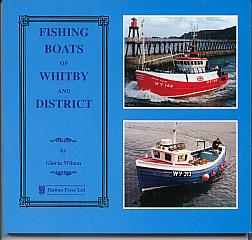 Gloria
Wilson's excellent book provides a history of the coble, with photographs which
span design and development from the earliest sailing cobles. Copies
are now available through Amazon at
Gloria
Wilson's excellent book provides a history of the coble, with photographs which
span design and development from the earliest sailing cobles. Copies
are now available through Amazon at
https://www.amazon.co.uk/
Plans for
home built cobles at 10, 12 and 15 feet (3,3.7 and 4.6m) are available from
Selway Fisher Design. www.selway-fisher.com
TradBoat ©
Charles Smith Publications
Last updated: 12 Jan 2023





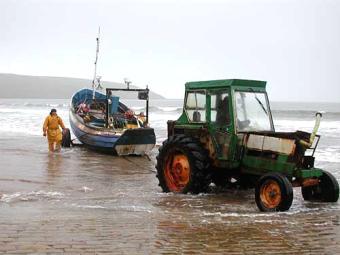
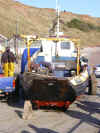
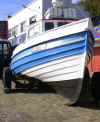
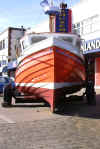
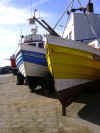




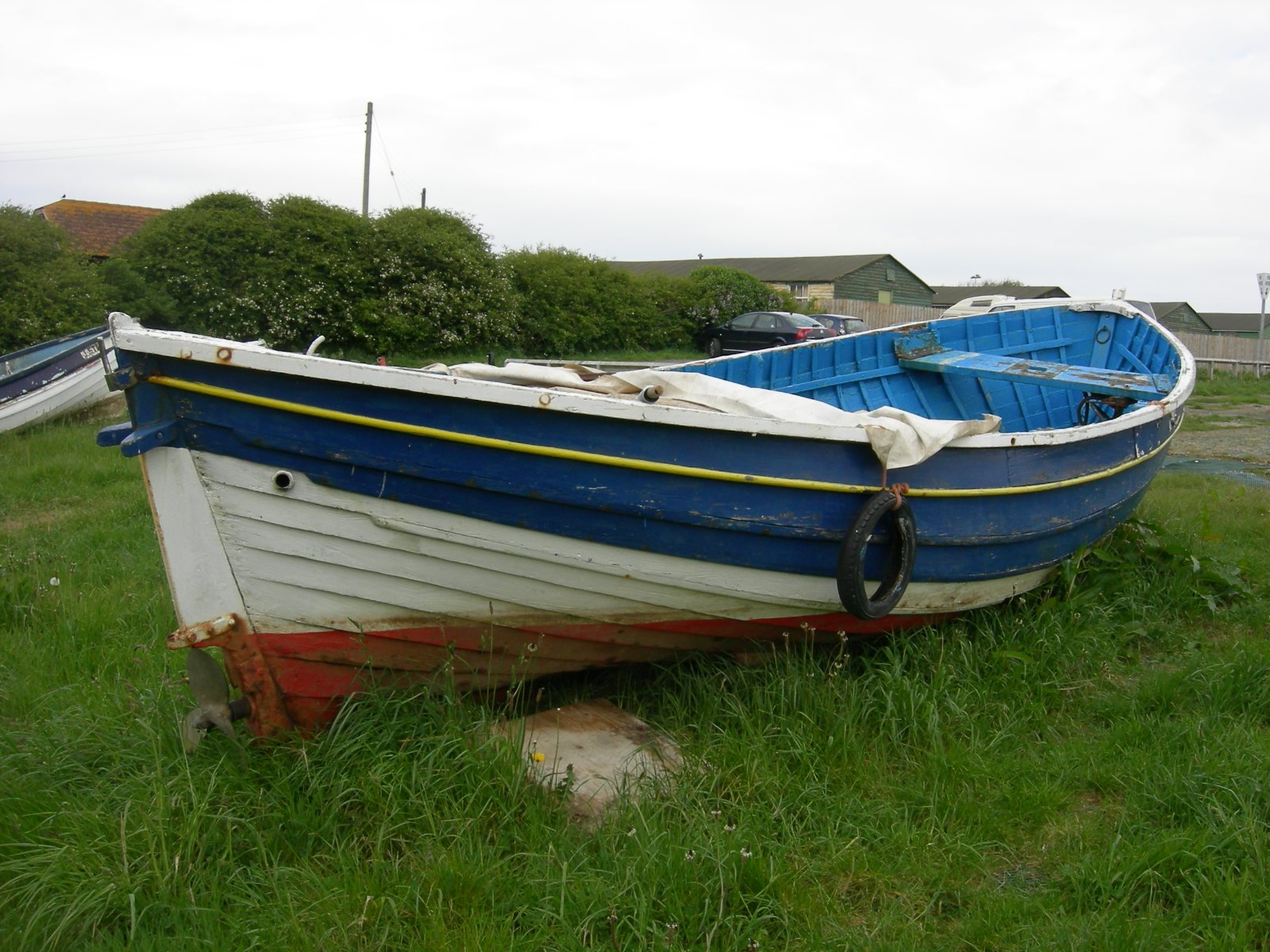
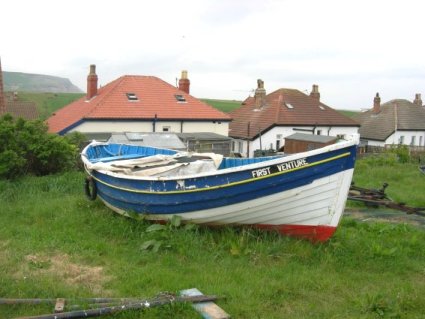
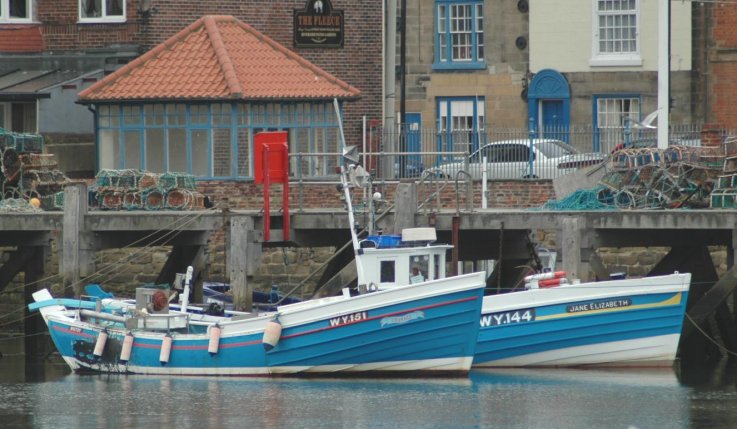





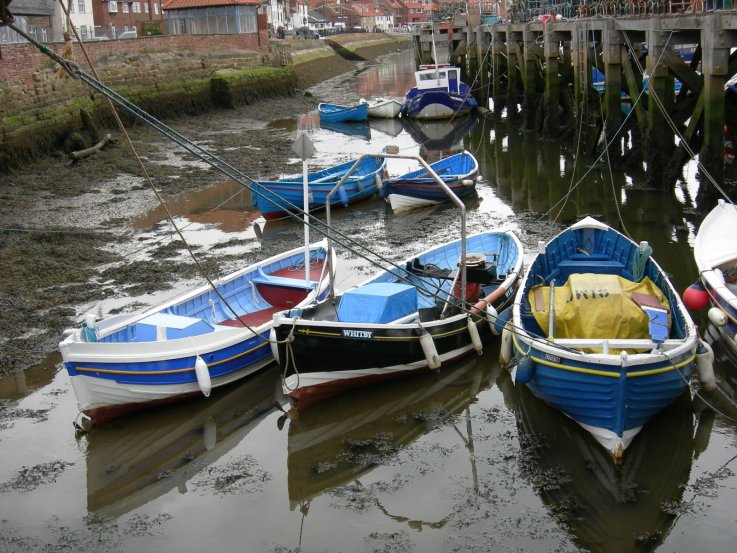







 Sources
Sources In
contrast to the Filey boats this is Three Brothers; restored and to be
seen under sail. She
has less sheer than usual and so is much flatter to allow beam trawling as
well as passenger carrying. Like the Filey boats, these Bridlington
cobles had no keel, and were held up to the sea by very deep rudders, which
could be unshipped in harbour, or on the beach, and used as gangplanks. Unlike
the Filey boats they returned to harbour. Sixty years ago there were a great
many sailing cobles in Bridlington, and the fishermen were extraordinarily
skilful in handling them, with the final position against the pier being made
by oar and a 30ft. boathook.
In
contrast to the Filey boats this is Three Brothers; restored and to be
seen under sail. She
has less sheer than usual and so is much flatter to allow beam trawling as
well as passenger carrying. Like the Filey boats, these Bridlington
cobles had no keel, and were held up to the sea by very deep rudders, which
could be unshipped in harbour, or on the beach, and used as gangplanks. Unlike
the Filey boats they returned to harbour. Sixty years ago there were a great
many sailing cobles in Bridlington, and the fishermen were extraordinarily
skilful in handling them, with the final position against the pier being made
by oar and a 30ft. boathook.

 Bridlington
Sailing Coble Preservation Society web site carries additional photographs
of Three Brothers together with older coble photos and a history of the
builder. The Society, has taken over the running of the small harbour
museum in Bridlington known as Harbour Heritage. The
Three Brothers restored by Bridlington Harbour Commissioners and owned
by them, is now leased to the Society and used as a working exhibit for the
Harbour Heritage museum. Membership is welcome.
Bridlington
Sailing Coble Preservation Society web site carries additional photographs
of Three Brothers together with older coble photos and a history of the
builder. The Society, has taken over the running of the small harbour
museum in Bridlington known as Harbour Heritage. The
Three Brothers restored by Bridlington Harbour Commissioners and owned
by them, is now leased to the Society and used as a working exhibit for the
Harbour Heritage museum. Membership is welcome.  The
Society brings together all those interested in the working boats of the North
East of England and has over 100 members in Britain, Europe and North
America. Membership includes professional fishermen and amateur sailors,
historians and ship modellers. All find the local boats - the
traditional fishing cobles and the larger decked inshore trawlers (or
Keelboats) for example.. CKS holds several meetings
on the coast each year, publishes a journal three times a year and is always
ready to help with queries about these craft.
The
Society brings together all those interested in the working boats of the North
East of England and has over 100 members in Britain, Europe and North
America. Membership includes professional fishermen and amateur sailors,
historians and ship modellers. All find the local boats - the
traditional fishing cobles and the larger decked inshore trawlers (or
Keelboats) for example.. CKS holds several meetings
on the coast each year, publishes a journal three times a year and is always
ready to help with queries about these craft. The
Hartlepool Historic Quay is a serious source for those interested in these
fishing boats. The museum has a selection of models illustrating the
boats by type, well set out explanations of each type, plus three full size
cobles on shore. Two
of these are typical of the robust transom sterned types and one of these is
displayed complete with rig in the museum building. Of the other
two displayed on the quayside one is a double ended type.
The
Hartlepool Historic Quay is a serious source for those interested in these
fishing boats. The museum has a selection of models illustrating the
boats by type, well set out explanations of each type, plus three full size
cobles on shore. Two
of these are typical of the robust transom sterned types and one of these is
displayed complete with rig in the museum building. Of the other
two displayed on the quayside one is a double ended type. 